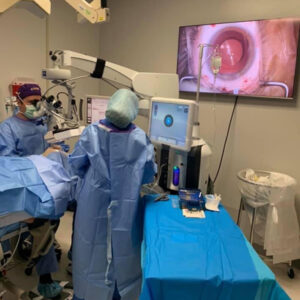ASCRS News
December 2022
by Liz Hillman
Editorial Co-Director
With recent case reports showing rare but serious adverse effects with use of the only FDA-approved therapeutic drop for temporary correction of presbyopia —VUITY (pilocarpine hydrochloride ophthalmic solution, Allergan)—and the expanded warning label provided by the company, EyeWorld spoke with Dagny Zhu, MD, to gain additional insights and perspectives. Dr. Zhu has been prescribing VUITY since December 2021. She commented on the adverse effects, her recommendations for counseling and prescribing, and an off-label use she has found.
In the months since VUITY became commercially available, there have been some papers and case reports published showing cases of retinal detachment and vitreofoveal traction.1,2,3 The possibility of retinal detachment with a miotic is not new,4 but of note, in 30-day Phase 3 clinical trials for VUITY, there were no cases of retinal detachment or angle closure.5
Dr. Zhu said that she has never experienced retinal issues when prescribing VUITY (or pilocarpine off label for other situations). “It’s a rare thing, but when you’re using it among potentially millions of people, you’re going to have a couple of cases here and there,” she said.
Dr. Zhu explained that miotic drops work by pushing the ciliary body forward, causing traction on the vitreous body, which can potentially cause traction on the peripheral retina.
“It’s something we were already aware of with all miotic drops. It’s definitely something that prescribers should be counseling on because it is associated with that class of drugs,” Dr. Zhu said. “Even though it’s rare, it’s important to counsel your patients on the symptoms of retinal detachment including flashes and floaters, and [let them know] to call the doctor right away.”
Dr. Zhu said this risk is significantly decreased if the patient doesn’t have peripheral retinal pathology. As such, she performs a full, dilated retinal exam on all patients before they’re prescribed VUITY, making sure there are no holes, tears, or lattice. Patients coming in for VUITY might never have had a dilated eye exam before, she said.
Dr. Zhu said in addition to those with existing retinal conditions, myopes are at increased risk for retinal detachments. “I haven’t found myself using it in many myopes, but that is one group where I would be more cautious. It’s especially important to identify patients who have had LASIK to correct their myopia in the past. Even though they no longer have a myopic refractive error, they may still have retinal changes,” Dr. Zhu said.
In terms of some of the common side effects that are more of a nuisance—brow ache, headache, hyperemia—Dr. Zhu said that she has had patients experience these effects, but frequently they go away after a week or so of using the product.
Dr. Zhu said most of her patients don’t come in asking or knowing about VUITY. “Some people don’t realize losing their near vision is a normal part of aging because they’ve had perfect vision all of their life and have never needed an eye doctor,” she said, explaining that they come in when this happens thinking something is wrong. “Those are the patients who you are serving for the first time, so you want to use it as an opportunity to provide comprehensive eyecare. … In a lot of these patients, I’m prescribing VUITY as a bridge until they’re ready for more permanent surgery down the road.”
Dr. Zhu also told EyeWorld how she has used generic pilocarpine off label before VUITY was available in some patients with glare, halo, and higher order aberrations.
“We’ve known that a smaller pupil decreases higher order aberrations and increases quality of vision because with a smaller pupil you’re filtering out those peripherally scattered rays, so you’re getting more focused, well-defined rays that enter to the back of the macula. That’s what I wanted from a pupil-modulating drop,” she said.
After VUITY became available, Dr. Zhu said she’s been prescribing it to patients off label with success in lessening their symptoms (usually positive dysphotopsias).
“I think among refractive surgeons, we don’t want to jump straight to surgery. … Give [VUITY] a try and if it works, you’ve avoided a surgical intervention,” Dr. Zhu said.
About the physician
Dagny Zhu, MD
NVISION Eye Centers
Rowland Heights, California
References
- Eton EA, et al. Rhegmatogenous retinal detachment following initiation of pilocarpine hydrochloride ophthalmic solution 1.25% for treatment of presbyopia. Retin Cases Brief Rep. 2022. Online ahead of print.
- Al-Khersan H, et al. Retinal detachments associated with topical pilocarpine use for presbyopia. Am J Ophthalmol. 2022;242:52–55.
- Amarikwa L, et al. Vitreofoveal traction associated with pilocarpine for presbyopia. Ophthalmic Surg Lasers Imaging Retina. 2022;53:410–411.
- Alpar JJ. Miotics and retinal detachment: a survey and case report. Ann Ophthalmol. 1979;11:395–401.
- Waring GO, et al. Safety and efficacy of AGN-190584 in individuals with presbyopia: the GEMINI 1 Phase 3 randomized clinical trial. JAMA Ophthalmol. 2022;140:363–371.
Relevant disclosures
Zhu: Allergan
Contact
Zhu: dagny.zhu@gmail.com



